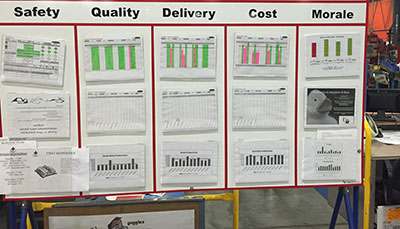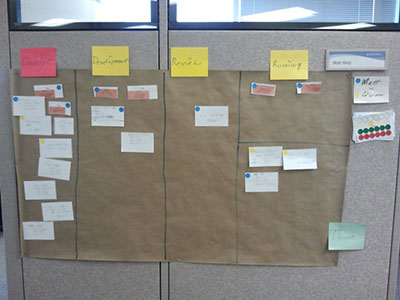Gemba Board A Handy Visual Management Method
When you are a more visual person, you may be looking for a good tool that allows you to visualize your workplace the best way. One of the best tools that you can use is the Gemba Board.
Learn about Six Sigma for free.
The Gemba Board is a Visual Management Tool that is very effective both in terms of monitoring as well as in terms of communicating what is happening in the workplace.
Learn about Six Sigma for free.
The Gemba Board is a Visual Management Tool that is very effective both in terms of monitoring as well as in terms of communicating what is happening in the workplace.
One of the main advantages of using a Gemba Board is the fact that with this tool, you will be allowing everyone to know exactly where the problem relies on, what everyone is doing to solve it or improve it, and where you are standing at the moment. This allows employees to never forget about the main goals and objectives of the organization.
Discover what is the Gemba Walk.
Discover what is the Gemba Walk.
The truth is that a Gemba Board is a great visualization tool that allows to anyone who works at the workplace and sees it, immediately understands the status of that unit, what the current status is, and what improvements are needed.
But Why Is The Gemba Board So Important?
While the Gemba walk is important and allows management and leaders to see what is happening in the real place with their own eyes, as well as to find the solutions for the problems, the process will only begin when the implementation of the solutions start. And they will always start with employees or by their hands. So, making sure that everyone who works in the organization is fully aware, all the tie, of the actions and decisions, is the way to go. This is what will allow everyone to do better no matter if we're talking about an operator, a manager, or even the owner of the organization.
Check out a Gemba Walk checklist and template.
Another benefit of using a Gemba Board is the fact that it provides real-time information as well as feedback. So, the information is always updated which ensures that everyone knows where they stand at the moment.
While you may assume that there are some workplaces that just don't need a Gemba Board, you are wrong. The truth is that it can be used within the entire organization from the offices to the shop floor.
Learn more about statistical process control charts.
Check out a Gemba Walk checklist and template.
Another benefit of using a Gemba Board is the fact that it provides real-time information as well as feedback. So, the information is always updated which ensures that everyone knows where they stand at the moment.
While you may assume that there are some workplaces that just don't need a Gemba Board, you are wrong. The truth is that it can be used within the entire organization from the offices to the shop floor.
Learn more about statistical process control charts.
How Should The Gemba Board Be?
When you are trying to create a Gemba Board, you need to make sure that it includes as much information as you can but it also should be easy to understand. Some of this information includes delivery metrics, material flow, quality, productivity, the workplace safety, among others.
A Gemba Board should always be visible to all workers of the organization and the color should be used in an efficient way.
So, ultimately, a Gemba Board should be well organized, clean, easily understood, managed by involving everyone, and it should communicate progress.
A Gemba Board should always be visible to all workers of the organization and the color should be used in an efficient way.
So, ultimately, a Gemba Board should be well organized, clean, easily understood, managed by involving everyone, and it should communicate progress.
How To Start A Gemba Board?
Before you actually start a Gemba Board, you need to decide which areas are going to be affected. So, the first thing that you need to do is brainstorm. After knowing where you are implementing the Gemba Board, you need to come up with the right way to communicate the information and metrics as well as to find a place where all the workers in the organization are able to see it.
After everything is all set, you need to make a small meeting to explain all the workers in the organization about the Gemba Board, what it means, and the responsibilities of each one of the individuals, teams, and departments of the organization.
After everything is all set, you need to make a small meeting to explain all the workers in the organization about the Gemba Board, what it means, and the responsibilities of each one of the individuals, teams, and departments of the organization.





 RSS Feed
RSS Feed